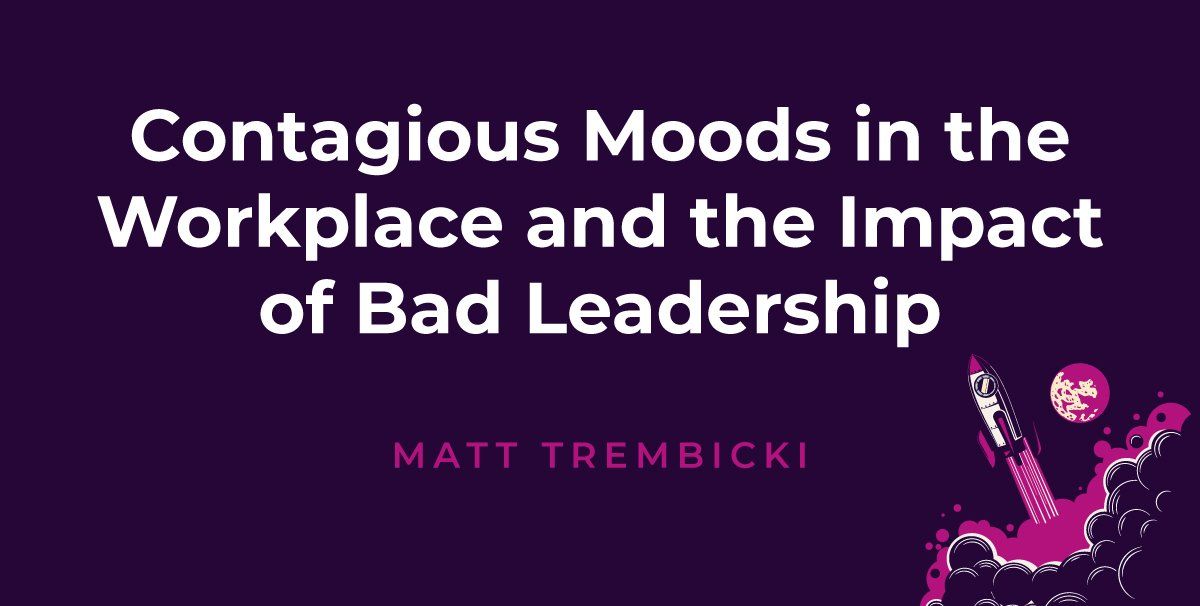Contagious Moods in the Workplace and the Impact of Bad Leadership
Have you ever gone into the office in a great mood only to sit down at your desk and come face to face with a co-worker who is NOT in a great mood? It can be a buzzkill. And others feel it too.
Why? Because emotions are contagious—they can spread just like a cold. And the big problem with emotions is that you can’t see them to protect yourself and ward off the bad ones.
There’s a scientific name for this “catching” where our bodies subconsciously mimic the facial expressions of others. This is called Emotional Contagion (EC).
EC happens on a primal level and can impact primates and other animals, so it makes sense that EC can—in the same way—spread moods across offices in humans and drastically impact the environment, for better or worse. So, it’s up to us to decide if our office will be contagious positivity or negativity, and the lion’s share of determining which side we come down on stems from the leadership down.
The Impact of Bad Leadership
We have all had managers that prescribe to the “do as I say, not as I do” code of conduct. That simply doesn’t fly anymore in 2021. If a boss or manager wants a positive environment, they must lead by example. Translation: Foster positivity.
Think about it: People quit bad bosses, and bad managers lead to lousy engagement and high turnover. But the impact of a bad boss is even greater than those factors—it can even lead to higher rates of office sickness. But don’t just take my word for it—hard data shows that feelings of happiness can decrease up to 86% by having constant contact with a bad boss.
The Impact of Positive Culture
The good news is that offices have picked up on the impact of EC and have started to make programs to facilitate positive EC. While that sounds amazing—and things like ball pits and ping pong tables are obvious elements to create increased EC—we have to ask: In 2021, is that enough?
Survey says? No. This survey from August 2021 states that 85% of the global workforce isn’t actively engaged. With the “great resignation” underway, employers must create that engagement and positivity constantly. It is proven that positivity and negativity spread. Since society is fighting a lot of negativity (especially these days post-COVID), we must fight even harder to counteract those factors. Clearly, it is going to take far more than more ping pong to remedy this malady.
How to Increase Positivity Contagiousness
So, you’re probably wondering: Now what? Forbes had an excellent article centering on this subject, which offered five proactive steps to improve our work culture in 2021.
Among these steps are:
- Rewarding Prosocial Behavior (praise and support any words and actions that are intended to help and encourage others)
- Looking Beyond Credentials (focus on instilling hiring practices that include not just things like experience and education, but also things like people skills and a fantastic attitude)
- Promoting Autonomy (just say no to micromanagement, which is known to lower morale, stifle innovation, and kill creativity)
- Adopting the Open Door Policy (let your employees know—by your actions—that your door is always open)
- And finally, Embracing Technology (use modern tech to help your organization better communicate, thus fostering community).
Emotional Contagion is a real thing, one that we—as leaders and employees—must consider at work. We must remain alert and aware of how our behavior impacts others.




